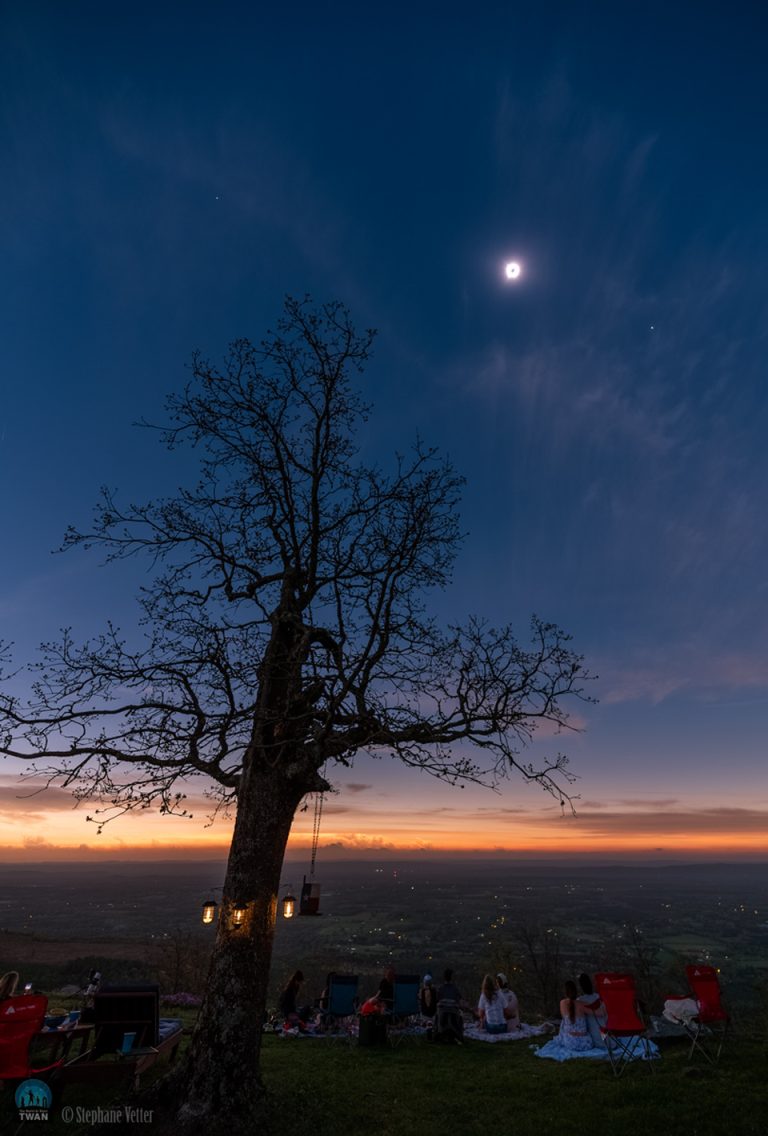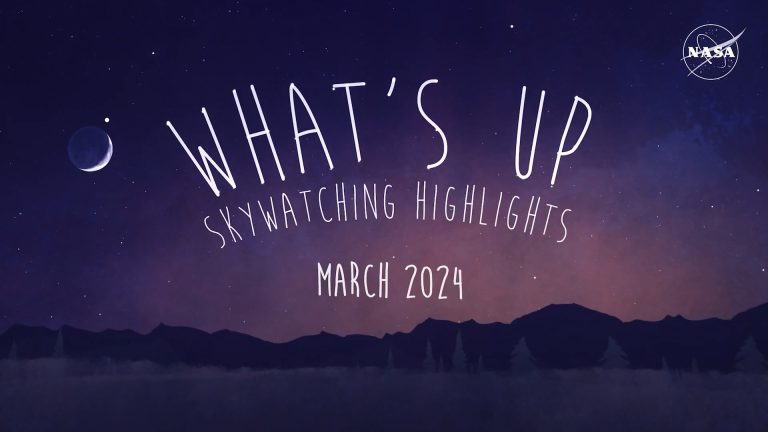全食日周围的行星
在天空中可以看到一个被明亮的日冕包围的完全日食的太阳。在前景中,几个人在一棵大树旁看着它。在被遮挡的太阳的右边是明亮的金星,而在它的左边是几乎同样明亮的木星。有关更多详细信息,请参阅说明。

在天空中可以看到一个被明亮的日冕包围的完全日食的太阳。在前景中,几个人在一棵大树旁看着它。在被遮挡的太阳的右边是明亮的金星,而在它的左边是几乎同样明亮的木星。有关更多详细信息,请参阅说明。

四月的天空会发生什么?一些易于发现的行星,还有时间观测彗星12P,以及如果你不在日全食路径上如何欣赏本月的日食。

三月份的天空会发生什么?与月亮亲密配对,水星现身,微弱的月食,还有机会看到彗星。

二月份的天空会发生什么?金星和火星是一对,木星和月球是对方的情人,观测M81,又名“波德星系”。

2024年1月19日 Jupiter over 2 Hours and 30 Minutes Image Credit & License: Aurélien Genin Explanation: Jupiter, our Solar System’s ruling gas giant, is also the fastest spinning planet, rotating once in less than 10 hours. The gas giant doesn’t rotate like a solid body though. A day on Jupiter is about 9 hours and 56 minutes long at the poles, decreasing to 9 hours and 50 minutes near the equator. The giant planet’s fast rotation creates strong jet streams, separating its clouds into planet girdling bands of dark belts and bright zones. You can easily follow Jupiter’s rapid rotation in this sharp sequence of images from the night of January 15, all taken with a camera and small telescope outside of Paris, France. Located just…

2023年12月28日 Jupiter and the Geminid Image Credit & Copyright: Gaurav Singh Explanation: For a brief moment, this brilliant fireball meteor outshone Jupiter in planet Earth’s night. The serendipitous image was captured while hunting meteors under cold Canadian skies with a camera in timelapse mode on December 14, near the peak of the Geminid meteor shower. The Geminid meteor shower, asteroid 3200 Phaethon’s annual gift, always arrives in December. Dust shed along the orbit of the mysterious asteroid causes the meteor streaks, as the vaporizing grains plow through our fair planet’s upper atmosphere at 22 kilometers per second. Of course Geminid shower meteors appear to radiate from a point in the constellation of the Twins. That’s below and left of this frame. With bright Jupiter on…

2023年11月28日 Ganymede from Juno Image Credit & Copyright: NASA/JPL-Caltech/SwRI/MSSS; Processing & License: Kevin M. Gill; Explanation: What does the largest moon in the Solar System look like? Jupiter‘s moon Ganymede, larger than even Mercury and Pluto, has an icy surface speckled with bright young craters overlying a mixture of older, darker, more cratered terrain laced with grooves and ridges. The cause of the grooved terrain remains a topic of research, with a leading hypothesis relating it to shifting ice plates. Ganymede is thought to have an ocean layer that contains more water than Earth — and might contain life. Like Earth’s Moon, Ganymede keeps the same face towards its central planet, in this case Jupiter. The featured image was captured in 2021 by NASA’s robotic…

2023年11月24日 Stereo Jupiter near Opposition Image Credit & Copyright: Marco Lorenzi Explanation: Jupiter looks sharp in these two rooftop telescope images. Both were captured on November 17 from Singapore, planet Earth, about two weeks after Jupiter’s 2023 opposition. Climbing high in midnight skies the giant planet was a mere 33.4 light-minutes from Singapore. That’s about 4 astronomical units away. Jupiter’s planet girdling dark belts and light zones are visible in remarkable detail, along with the giant world’s whitish oval vortices. Its signature Great Red Spot is still prominent in the south. Jupiter rotates rapidly on its axis once every 10 hours. So, based on video frames taken only 15 minutes apart, these images form a stereo pair. Look at the center of the pair and…

2023年11月14日 Three Planets Rock Image Credit & Copyright: Giovanni Passalacqua; Text: Liz Coelho (Pikes Peak) Explanation: In the fading darkness before dawn, a tilted triangle appeared to balance atop a rock formation off the southern tip of Sicily. Making up the points of the triangle are three of the four brightest objects visible in Earth’s sky: Jupiter, Venus and the Moon. Though a thin waning crescent, most of the moon’s disk is visible due to earthshine. Captured in this image on 2022 April 27, Venus (center) and Jupiter (left) are roughly three degrees apart — and were headed toward a close conjunction. Conjunctions of Venus and Jupiter occur about once a year and are visible either in the east before sunrise or in the west…

2023年11月3日 Jupiter by Moonlight Image Credit & Copyright: Giorgia Hofer Explanation: That bright beacon you’ve seen rising in the east just after sunset is Jupiter. Climbing high in midnight skies, our Solar System’s ruling gas giant was at its 2023 opposition, opposite the Sun in planet Earth’s sky, on November 2. But only a few days earlier, on October 28, the Moon was at its own opposition. Then both Full Moon and Jupiter could share this telephoto field of view. The celestial scene is composed from two exposures, one long and one short, blended to record bright planet and even brighter Moon during that evening’s partial lunar eclipse. Moonlight shining through the thin, high clouds over northern Italy creates the colorful iridescence and lunar corona….